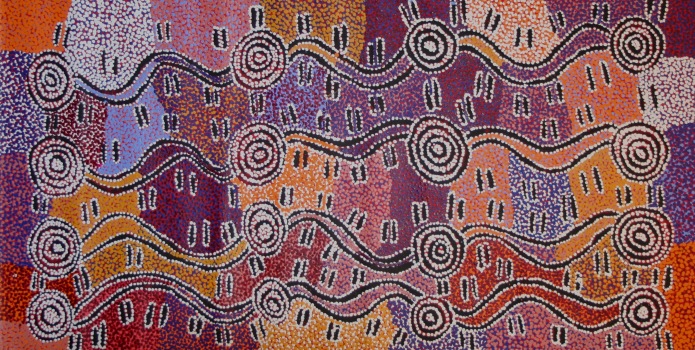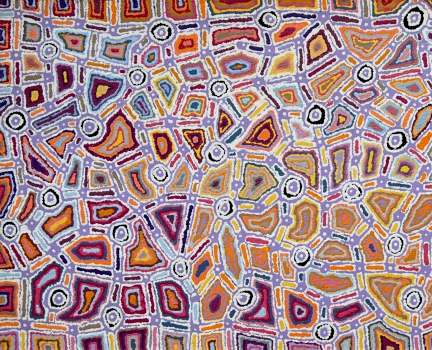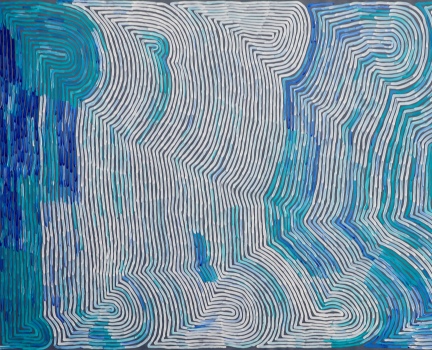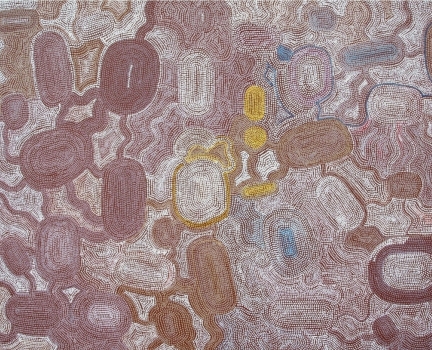Water Dreaming
For Aboriginal people living a traditional life in the desert areas of Australia, water, and knowledge of where it could be found, was essential to survival. Therefore, throughout Aboriginal Australia all water sources – rockholes, fresh water springs, soakages, rivers, underground water and billabongs – form a vital part of traditional knowledge and ritual life. Rockholes and other water sources were, and where possible still are, constantly maintained so that the water supply remains fresh and accessible.
Ceremonies keep alive the memory of both the creation and the location of these sites. Aboriginal people meet for ceremonies beside water holes and their birthplaces are generally near one. Special ceremonies are performed seasonally to ensure that rains come to regenerate the plants and to provide food for both animals and people.
Just one of the large Water Dreaming stories – Ngapa Jukurrpa - belongs to the Warlpiri people whose lands are located in the Tanami Desert, east of the Western Australia-Northern Territory border. There are 5,000–6,000 Warlpiri, living mostly in a few towns and settlements scattered through their traditional lands. Their largest community is at Yuendumu, but many live also at Willowra, Lajamau, Nyirrpi, Mount Allen and smaller settlements, while some have moved to Alice Springs and Tennant Creek.
The Warlpiri Water Dreaming story, Ngapa Jukurrpa, focuses on sites such Pirlinyanu, which is about 65 km west of Yuendumu, and Puyurru, north west of Yuendumu. It relates how two Jangala men, rainmakers, sang the rain, unleashing a giant storm that collided with another storm from Warpurtali. The two storms travelled across the country from Karlipinpa near Kintore. A Kirrkarlanji (brown falcon, Falco berigora) carried the storm further west, until it dropped it at Pirlinyarnu forming an enormous maliri (lake). Whenever it rains, hundreds of Ngapangarlpa (bush ducks) still flock to Pirlinyarnu. A mulju (soakage) exists in this place today. At Puyurru, Shorty Jangala Robertson’s birthplace, the falcon dug up a warnayarra (rainbow serpent). The serpent carried water with it to create another large lake.
The Kirda (custodians) for this Jukurrpa are Jangala and Jampijinpa men and Nangala and Nampijinpa women.
Warlpiri artist Maureen Hudson Nampijinpa paints artworks associated with the Water Dreaming site of Mikantji, far to the west of Alparakinya in Central Australia. Her work depicts the water holes of the area with interconnecting lines indicating the movement of water across the landscape. The varying intensity of colour in the design shows where the water is on or close to the surface of the land, or where it is deeper below the surface.
Western Desert Pintupi artists such as Ronnie Tjampitjinpa also paint Ngapa Jukurrpa. These paintings are a representation of Pintupi country in the region west of Kintore in Western Australia. It is in this area that there are a large number of water soakages where Tingari Men stopped to obtain water during their epic journeys. The water lies in shallow lakes and depressions before it starts to spread outwards through the desert sand-dunes.
Creation Stories of the Tingari Cycle are an important body of knowledge concerning the Tingari ancestors of the Creation Dreaming period. The Tingari men and women travelled across great distances and laid down a body of ceremonies and other law which subsequently formed the basis of young men’s higher (post–initiation) education. The stories themselves are communicated only to initiated men.
Read More
Back to Aboriginal Dreamtime Stories





